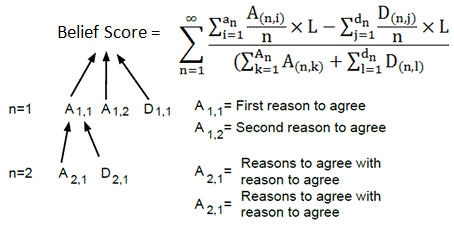I once took a course in logic taught by a professor of philosophy, a discipline in which formal logic often plays a crucial role.
My proposal involves quantifying the input of logic professors who "authenticate" the logic of an argument, juxtaposed against those who "contend" with the logic of the same argument. Such data could potentially bolster the credibility of ideas that have been meticulously scrutinized and validated.
Consider this modified equation, using a ratio to add or subtract points from a belief based on the input of logic professors:
Ratio = Number of times a certified logic instructor has authenticated the logic of a given argument (LPV) / Number of times a certified logic instructor has contested the logic of a given argument (LPC).
Using this ratio, if a logic professor opposes a reason that underpins your conclusion, the overall score would decrease proportionately. This is because the action of contesting is twice removed from directly affirming the belief, which is reflected in the ratio.
It's important to note that these equations would be adjusted and fine-tuned over time to improve the site's user engagement and overall performance. Our goal is to create a system that is flexible, responsive, and continually improving based on user interaction and feedback. Your thoughts and suggestions on this proposed approach would be greatly appreciated.
a) Fundamental Beliefs or Principles one must reject to also reject this belief:- Rejection of Expertise: To disregard the idea of using evaluations from philosophy professors who have taught formal logic means rejecting the concept that individuals who have studied and taught critical thinking and formal logic possess a special skill set that can be used to assess the validity of arguments effectively.
- Rejection of Academic Knowledge: This also entails the rejection of the principle that academia, specifically in the field of philosophy and formal logic, contributes significantly to understanding and assessing arguments.
- Rejection of Objective Assessment: This further implies rejecting the idea that an argument's validity can be objectively analyzed based on established principles of formal logic.
b) Alternate Expressions:#LogicCheckedByAcademics- #FormalLogicValidation
- "Endorsed by Philosophy Educators"
c) Objective Criteria to Measure the Strength of this Belief:- Number of Philosophy Professors who have taught Formal Logic that endorse the argument.
- Consistency of their evaluation with established principles of formal logic.
- The acceptance and application of their assessments in resolving disagreements or strengthening arguments.
d) Shared Interests between Those Who Agree/Disagree:- Both sides likely value logical consistency and sound arguments.
- Both would probably appreciate a fair and objective assessment process.
- Both parties likely want the discussion or debate to contribute to truth and understanding, not merely winning an argument.
e) Key Opposing Interests between Those Who Agree/Disagree (that must be addressed for mutual understanding):- Those who agree might feel that input from Philosophy Professors who have taught Formal Logic adds credibility and objectivity to the discussion.
- Those who disagree might fear this approach overly privileges academic knowledge, potentially excluding valuable perspectives from non-academics or individuals with practical, rather than formal, understanding of logic.
- For constructive dialogue, it is necessary to acknowledge the value of expert input while ensuring that all meaningful and insightful contributions are given due consideration.
f) Solutions:- Create a balanced system where validations from philosophy professors who have taught formal logic are one of many factors considered in an argument's strength.
- Incorporate input from a diverse range of experts, not just philosophy academics experienced in formal logic.
- Implement a system that allows users to challenge or question the validations from these philosophy professors, fostering an open dialogue.
- Logical Arguments:
- Expertise Principle: Philosophy professors who have taught formal logic have acquired expert knowledge, making them well-suited to evaluate logical coherence in arguments.
- Supporting Evidence (data, studies):
- Studies on expertise suggest that experts, due to their training and experience, have deeper knowledge and insights in their areas of specialization (Ericsson, K. A., & Lehmann, A. C. (1996). Expert and exceptional performance: evidence of maximal adaptation to task constraints. Annual review of psychology, 47(1), 273-305).
- Supporting Books:
- "Thinking Fast and Slow" by Daniel Kahneman: This book, while not directly related to philosophy professors, discusses the differences between expert thinking and intuitive thinking.
- Supporting Videos (movies, YouTube, TikTok):
- "Crash Course Philosophy" on YouTube: A video series that provides an introduction to philosophy and logical reasoning.
- Supporting Organizations and their Websites:
- The American Philosophical Association (apaonline.org): An organization supporting the work of philosophers and the value of their expertise.
- Supporting Podcasts:
- "Philosophy Bites" is a podcast that showcases the insights of contemporary philosophers on a wide range of topics.
- Unbiased Experts:
- Professors of Philosophy who have taught formal logic, as their training ideally positions them to be impartial arbiters of logical consistency.
- Benefits of Belief Acceptance (ranked by Maslow categories):
- Psychological Needs: Encourages intellectual growth and cognitive satisfaction through engaging with logically sound arguments.
- Belonging and Love Needs: Facilitates fair and meaningful dialogue, promoting a sense of community.
- Esteem Needs: Upholds the value of academic knowledge and expertise, contributing to societal respect for intellectual pursuits.
- Self-Actualization: Supports the pursuit of truth and understanding, key aspects of personal and societal development.
















